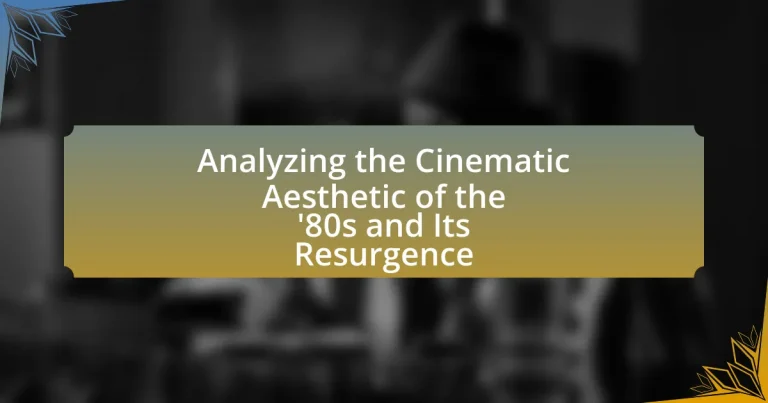The article analyzes the cinematic aesthetic of the 1980s, characterized by vibrant colors, synthesizer-heavy soundtracks, and a blend of realism with fantasy. It explores the evolution of visual styles during the decade, highlighting key elements such as neon lighting, distinctive fashion, and innovative special effects that defined films like “The Breakfast Club” and “E.T. the Extra-Terrestrial.” The article also examines the impact of technology on aesthetics, prevalent themes in ’80s cinema, and the influence of genre on visual storytelling. Furthermore, it discusses the resurgence of ’80s aesthetics in modern cinema, the role of nostalgia, and how filmmakers can effectively incorporate these elements while maintaining originality.
What defines the cinematic aesthetic of the ’80s?
The cinematic aesthetic of the ’80s is defined by vibrant colors, synthesizer-heavy soundtracks, and a blend of realism with fantasy elements. This era saw the rise of blockbuster films characterized by high production values, innovative special effects, and a focus on youth culture, as exemplified by movies like “The Breakfast Club” and “E.T. the Extra-Terrestrial.” The use of neon lighting and stylized visuals became iconic, reflecting the cultural shifts and technological advancements of the time, such as the introduction of home video and cable television, which expanded audience access to films.
How did visual styles evolve during the 1980s?
Visual styles evolved significantly during the 1980s, marked by the rise of vibrant colors, bold graphics, and innovative special effects. This decade saw the emergence of new technologies, such as computer-generated imagery (CGI), which transformed visual storytelling in films like “Tron” (1982) and “The Last Starfighter” (1984). Additionally, the influence of music videos, particularly from MTV, introduced a fast-paced, visually dynamic aesthetic that permeated cinema, exemplified by films like “Flashdance” (1983) and “Top Gun” (1986). The combination of these elements led to a distinctive visual language characterized by high contrast, neon colors, and a sense of escapism, reflecting the cultural zeitgeist of the era.
What were the key visual elements that characterized ’80s films?
The key visual elements that characterized ’80s films included vibrant color palettes, distinctive fashion styles, and innovative special effects. Vibrant color palettes often featured neon hues and high contrast, reflecting the era’s pop culture and music influences. Distinctive fashion styles, such as shoulder pads, leg warmers, and bold accessories, were prominently showcased, influencing character design and setting the tone for the films. Innovative special effects, including practical effects and early CGI, were utilized in films like “Tron” and “The Terminator,” enhancing the visual storytelling and creating memorable cinematic experiences. These elements collectively defined the aesthetic of ’80s cinema, making it recognizable and influential in subsequent decades.
How did technology influence the aesthetics of the decade?
Technology significantly influenced the aesthetics of the 1980s by introducing advanced visual effects and synthesizer-driven soundtracks that defined the era’s cinematic style. The advent of computer-generated imagery (CGI) allowed filmmakers to create visually stunning scenes that were previously impossible, as seen in films like “Tron” (1982), which showcased groundbreaking digital effects. Additionally, the widespread use of synthesizers in film scores, exemplified by the music of “Blade Runner” (1982), contributed to a distinctive sound that complemented the futuristic visuals, enhancing the overall aesthetic experience. This technological evolution not only shaped the visual and auditory landscape of the decade but also set a precedent for future filmmaking techniques.
What themes were prevalent in ’80s cinema?
Prevalent themes in ’80s cinema included the rise of individualism, the clash between good and evil, and the exploration of youth culture. Individualism was often depicted through protagonists who defied societal norms, as seen in films like “The Breakfast Club” and “Ferris Bueller’s Day Off.” The clear delineation of good versus evil was prominent in action films such as “Die Hard” and “Rambo,” where heroes faced off against clear antagonists. Additionally, youth culture was a significant focus, with movies like “Fast Times at Ridgemont High” capturing the experiences and challenges of adolescence. These themes reflect the socio-political climate of the decade, characterized by a desire for personal freedom and a reaction against established authority.
How did cultural and societal changes shape these themes?
Cultural and societal changes significantly shaped the themes of the ’80s cinematic aesthetic by reflecting the era’s values, fears, and aspirations. The rise of consumerism, technological advancements, and shifting social norms influenced filmmakers to explore themes of individualism, rebellion, and the impact of technology on human relationships. For instance, the emergence of blockbuster films like “E.T. the Extra-Terrestrial” and “The Breakfast Club” showcased the complexities of childhood and adolescence, resonating with a generation grappling with rapid societal changes. Additionally, the political climate, marked by the Cold War and economic shifts, prompted films to address issues of identity and existentialism, as seen in “Blade Runner.” These films not only mirrored the cultural landscape but also shaped public discourse, making the themes relevant and impactful.
What role did genre play in the aesthetic of the ’80s?
Genre significantly shaped the aesthetic of the ’80s by defining the visual and thematic elements prevalent in films, music, and fashion. The decade saw the rise of distinct genres such as action, horror, and teen comedies, each contributing unique stylistic features; for instance, action films like “Die Hard” emphasized high-octane visuals and intense soundtracks, while horror films like “A Nightmare on Elm Street” utilized surreal imagery and psychological tension. This genre-driven approach not only influenced the narrative structures but also dictated the cultural trends of the time, as seen in the popularity of neon colors and bold patterns in fashion, which were often associated with the vibrant energy of pop culture. The impact of genre on the ’80s aesthetic is evidenced by the box office success of films that adhered to these genre conventions, reflecting audience preferences and shaping the overall cultural landscape.
Why is the ’80s aesthetic significant in film history?
The ’80s aesthetic is significant in film history because it represents a distinct visual and thematic style that influenced a generation of filmmakers and audiences. This aesthetic is characterized by vibrant colors, bold fashion, and a blend of optimism and excess, which reflected the cultural and economic climate of the era. Notable films such as “The Breakfast Club,” “Back to the Future,” and “Blade Runner” exemplify this aesthetic, showcasing innovative cinematography and soundtracks that have left a lasting impact on popular culture. The resurgence of ’80s-inspired films and series in contemporary media, such as “Stranger Things,” further underscores its enduring relevance and influence in shaping modern storytelling and visual style.
What impact did ’80s films have on future cinematic trends?
’80s films significantly influenced future cinematic trends by popularizing genres such as action, horror, and teen comedies, which set the foundation for modern filmmaking. The decade introduced blockbuster filmmaking, exemplified by films like “E.T. the Extra-Terrestrial” and “Indiana Jones,” which emphasized high-concept storytelling and special effects. This era also saw the rise of franchises, as evidenced by the success of “Star Wars” and “Back to the Future,” establishing a model for sequels and merchandise that persists today. Additionally, the stylistic choices of ’80s films, including the use of synth-heavy soundtracks and vibrant visuals, have been revisited in contemporary cinema, influencing filmmakers like Edgar Wright and the Duffer Brothers in projects such as “Stranger Things.”
How do critics and audiences perceive the legacy of ’80s cinema?
Critics and audiences perceive the legacy of ’80s cinema as a significant cultural touchstone that shaped modern filmmaking and popular culture. This perception is supported by the era’s introduction of iconic genres such as action, horror, and teen comedies, which have influenced countless films and television shows since. Notable examples include the rise of blockbuster franchises like “Star Wars” and “Indiana Jones,” which set new standards for special effects and storytelling. Additionally, the nostalgic revival of ’80s aesthetics in contemporary media, such as the series “Stranger Things,” highlights the enduring impact of this decade on current pop culture. Critics often cite the era’s unique blend of innovation and commercial success as a defining characteristic of its legacy.
How has the ’80s cinematic aesthetic experienced a resurgence?
The ’80s cinematic aesthetic has experienced a resurgence through a combination of nostalgia-driven media, stylistic revival in contemporary films, and the influence of streaming platforms. This revival is evident in popular series like “Stranger Things,” which incorporates visual and thematic elements reminiscent of ’80s films, such as neon colors, synth-heavy soundtracks, and retro storytelling techniques. Additionally, films like “It Follows” and “Ready Player One” pay homage to the era’s aesthetics, showcasing the cultural impact of ’80s cinema on modern filmmaking. The resurgence is further supported by the rise of retro-themed merchandise and the popularity of ’80s music in current pop culture, reinforcing the decade’s lasting influence.
What factors have contributed to the revival of ’80s aesthetics in modern cinema?
The revival of ’80s aesthetics in modern cinema is primarily driven by nostalgia, cultural references, and the influence of digital technology. Nostalgia plays a significant role as audiences who grew up in the ’80s seek to reconnect with their childhood experiences, leading filmmakers to incorporate familiar visual styles, music, and themes from that era. Cultural references are prevalent in contemporary films and series, such as “Stranger Things,” which directly draws inspiration from ’80s pop culture, including movies, fashion, and music, thereby attracting both older viewers and new audiences. Additionally, advancements in digital technology have made it easier for filmmakers to replicate the distinctive visual elements of ’80s cinema, such as neon colors and retro special effects, enhancing the authenticity of the aesthetic. This combination of nostalgia, cultural homage, and technological capability has significantly contributed to the resurgence of ’80s aesthetics in modern cinema.
How have filmmakers incorporated ’80s styles into contemporary films?
Filmmakers have incorporated ’80s styles into contemporary films through visual aesthetics, soundtracks, and thematic elements. For instance, the use of neon colors and retro fashion in films like “Stranger Things” and “It Follows” evokes the vibrant visual style of the ’80s. Additionally, contemporary films often feature synth-heavy soundtracks reminiscent of iconic ’80s music, as seen in “Blade Runner 2049,” which pays homage to the original film’s score. Thematically, many modern films explore nostalgia and coming-of-age stories similar to classics like “The Breakfast Club” and “Ferris Bueller’s Day Off,” reinforcing the cultural impact of the ’80s on today’s cinema.
What role does nostalgia play in the resurgence of this aesthetic?
Nostalgia plays a crucial role in the resurgence of the ’80s cinematic aesthetic by evoking fond memories and emotional connections to that era. This emotional response is driven by the cultural significance of the ’80s, characterized by distinctive visual styles, music, and themes that resonate with audiences today. Research indicates that nostalgia can enhance consumer engagement and influence preferences, as seen in the popularity of ’80s-inspired films and television series, which often incorporate retro elements to attract viewers. For instance, the success of shows like “Stranger Things” demonstrates how nostalgia can effectively tap into collective memories, driving interest and viewership in contemporary media.
Which modern films exemplify the revival of ’80s aesthetics?
Modern films that exemplify the revival of ’80s aesthetics include “Stranger Things,” “It,” and “Ready Player One.” “Stranger Things” incorporates visual styles, music, and cultural references from the 1980s, effectively recreating the era’s nostalgic atmosphere. “It,” based on Stephen King’s novel, utilizes ’80s fashion and settings to enhance its horror elements, while “Ready Player One” features numerous references to ’80s pop culture, including video games and films, showcasing the decade’s influence on contemporary storytelling. These films collectively highlight the enduring appeal of ’80s aesthetics in modern cinema.
What specific elements from ’80s cinema are being reused or reinterpreted?
Specific elements from ’80s cinema being reused or reinterpreted include neon color palettes, synth-heavy soundtracks, and nostalgic themes of adventure and friendship. These elements are evident in contemporary films and series, such as “Stranger Things,” which employs a vibrant visual style reminiscent of ’80s aesthetics, while also featuring a synth-driven score that echoes the music of that era. Additionally, the revival of classic genres like sci-fi and horror, as seen in films like “It” and “Ready Player One,” showcases a blend of modern storytelling with the iconic tropes and narratives that defined ’80s cinema, reinforcing the cultural impact and lasting influence of that decade on today’s filmmakers.
How do audiences respond to these modern interpretations?
Audiences generally respond positively to modern interpretations of the ’80s cinematic aesthetic, appreciating the nostalgia and innovative storytelling techniques. This positive reception is evidenced by the success of films and series that incorporate ’80s elements, such as “Stranger Things,” which garnered critical acclaim and a large viewership, reflecting a strong connection to the original era’s style and themes. Additionally, audience engagement on social media platforms often highlights a sense of community and shared appreciation for the revival of ’80s culture, indicating that these interpretations resonate deeply with both those who experienced the original films and new viewers discovering them.
What are the implications of the ’80s aesthetic resurgence for the film industry?
The resurgence of the ’80s aesthetic significantly impacts the film industry by influencing production design, storytelling, and audience engagement. This revival leads filmmakers to incorporate vibrant colors, retro technology, and nostalgic themes reminiscent of ’80s cinema, appealing to both older audiences who experienced the original era and younger viewers drawn to its unique style. For instance, films like “Stranger Things” and “It” have successfully utilized ’80s aesthetics, resulting in increased box office revenues and viewership, demonstrating the commercial viability of this trend. Additionally, the resurgence fosters a cultural dialogue about nostalgia and identity, prompting filmmakers to explore themes of memory and the past, which resonate with contemporary societal issues.
How does the revival influence current filmmaking trends?
The revival of the ’80s cinematic aesthetic significantly influences current filmmaking trends by inspiring filmmakers to incorporate retro visual styles, storytelling techniques, and thematic elements reminiscent of that era. This resurgence is evident in the popularity of neon color palettes, synth-heavy soundtracks, and nostalgic references in films and series such as “Stranger Things” and “It,” which have achieved commercial success and critical acclaim. The trend reflects a broader cultural nostalgia, driving studios to invest in projects that evoke the emotional resonance of ’80s cinema, thereby shaping contemporary narratives and production designs.
What lessons can filmmakers learn from the ’80s aesthetic?
Filmmakers can learn the importance of vibrant color palettes and practical effects from the ’80s aesthetic. The decade is characterized by bold, saturated colors that evoke strong emotions and create memorable visuals, as seen in films like “The Breakfast Club” and “Blade Runner.” Additionally, the reliance on practical effects over CGI in movies such as “The Thing” and “Ghostbusters” emphasizes the tactile quality that can enhance viewer immersion. This approach not only fosters a sense of authenticity but also encourages creativity in storytelling and production design, making the aesthetic both timeless and influential in contemporary filmmaking.
How does this resurgence affect the marketing of films today?
The resurgence of the ’80s cinematic aesthetic significantly impacts the marketing of films today by leveraging nostalgia to attract audiences. Marketers utilize retro visuals, soundtracks, and themes reminiscent of the ’80s to evoke emotional connections, as seen in successful campaigns for films like “Stranger Things” and “It.” This strategy is supported by data indicating that nostalgia-driven content can enhance viewer engagement, with a study from the Journal of Consumer Research showing that nostalgic advertising increases purchase intentions by 20%. Consequently, the revival of ’80s elements in film marketing not only resonates with older audiences who experienced that era but also intrigues younger viewers, creating a broader appeal and driving box office success.
What practical tips can filmmakers use to incorporate ’80s aesthetics effectively?
Filmmakers can effectively incorporate ’80s aesthetics by utilizing vibrant color palettes, retro costumes, and synthesizer-heavy soundtracks. The vibrant color schemes, often characterized by neon hues and pastel shades, can evoke the visual style of iconic films from that era, such as “Blade Runner” and “The Breakfast Club.” Retro costumes, including high-waisted jeans, oversized jackets, and accessories like scrunchies, can enhance character authenticity and resonate with the audience’s nostalgia. Additionally, employing synthesizer-heavy soundtracks, reminiscent of composers like John Carpenter, can create an immersive auditory experience that aligns with the visual elements, reinforcing the overall ’80s vibe. These strategies are supported by the resurgence of ’80s-inspired media, indicating a strong cultural connection and audience appeal.
What common pitfalls should filmmakers avoid when emulating ’80s styles?
Filmmakers should avoid superficial nostalgia when emulating ’80s styles, as it can lead to a lack of authenticity. This means relying solely on visual elements like neon colors and retro fashion without understanding the cultural context and storytelling techniques that defined the era. For instance, many successful ’80s films, such as “The Breakfast Club” and “Back to the Future,” incorporated themes of youth identity and social issues, which resonated with audiences. Ignoring these deeper narratives can result in a hollow representation that fails to connect with viewers. Additionally, filmmakers should be cautious of overusing clichés and tropes that were prevalent in ’80s cinema, as this can make the work feel dated rather than a fresh homage.
How can filmmakers balance nostalgia with originality in their work?
Filmmakers can balance nostalgia with originality by incorporating familiar elements from past works while introducing innovative storytelling techniques and themes. For instance, they can reference iconic visual styles, soundtracks, or character archetypes from the ’80s, which evoke a sense of nostalgia, while simultaneously crafting unique narratives that resonate with contemporary audiences. This approach is evident in films like “Stranger Things,” which utilizes ’80s aesthetics but tells a fresh story that explores modern issues, thereby appealing to both nostalgic viewers and new fans. By blending these elements, filmmakers create a rich tapestry that honors the past while pushing creative boundaries.


